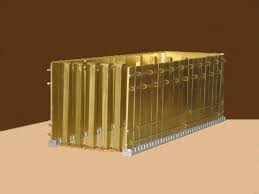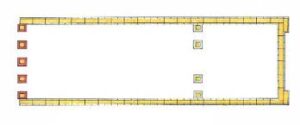The Structure of the Sanctuary
26:15-29 and 36:20-29
The structure of the Sanctuary DIG: Do you think the Canaanites saw Isra’el’s Tabernacle as God’s dwelling place on earth? How would the sight of this dwelling place strike terror in the hearts of the Canaanites? Why were the frames overlaid with gold? Why were the sockets made of silver?
REFLECT: What holds you together? Is your spiritual frame virtually indestructible? Why or why not? Does your base rest on the blood of Christ? Why or why not?
We have seen that the Tabernacle was a type of Christ, dwelling in the midst of His people. In these frames, bases and crossbars we see some beautiful and minute details, illustrating this eternal truth. A description of the framework for the construction of the Sanctuary was then given. This was the structure over which the coverings would be spread and into which the furniture would be placed.567

Make upright frames of acacia wood for the Sanctuary. The Hebrew word qeres, means frame of wood. The “walls” were not solid but consisted of wooden upright frames forming a trellised construction over which the white linen curtains were draped. If the “walls” had been solid, the colorful curtains could not have been seen from inside.568 This made the Sanctuary very portable. The boards, or frames, were made with shittim wood that foreshadowed Messiah’s humanity, particularly the incorruptibility of it. In fact, the Septuagint, Greek version of the TaNaKh, actually translates it incorruptible wood. For this reason He had to be made like His brothers in every way, in order that He might become a merciful and faithful high priest in service to God, and that He might make atonement for the sins of the people (Hebrews 2:17).569 And then the frames were overlaid with gold, which points to Christ’s divine glory. Each frame was ten cubits, or fifteen feet high and a cubit and a half, or two feet, three inches wide. They were laid out parallel to each other about two feet apart (26:15-17 and 29, 36:20-22).
The cosmic temple of the Canaanite god El had a dwelling place with frames and bases. It included a throne with a footstool, lamp and table, somewhat similar to the furniture in the Sanctuary. However, in contrast to ADONAI, who will neither slumber nor sleep (Psalm 121:4), the Canaanite god El’s dwelling place also had a chest for clothes and a bed.570

There would be forty-eight acacia wood frames altogether; twenty frames on each side of the Sanctuary and eight in the rear. There were twenty frames for the south side and forty silver bases were made to go under them – two bases for each frame were laid side by side to form a continuous foundation for the Sanctuary walls. Twenty frames and forty silver bases were also made for the north side. Each frame has two tenons, or projections at the end of it that fit into the two silver bases to form a mortise joint. Six frames were made for the back end, that is the west side, and two frames were made for the corners at the back end to give it extra support. Those two corners were doubled from the bottom all the way to the top, and fitted into a single gold ring to increase the stability of the whole Sanctuary. So the back end had eight frames and sixteen sliver bases (26:18-25, 36:23-29). Therefore, ninety-six silver bases formed the foundation, and upon them rested the whole Sanctuary. This tells us, in language too plain to be misunderstood, that redemption is the basis on which Christ has become the meeting-place between a holy God and a sinful people.571
As to the roof, did it have a peak or was it flat? This question is settled by the single word tent, which was specifically applied to the upper portion of the Sanctuary. Then Moses spread the tent over the Sanctuary . . . as ADONAI commanded (40:19). The common usage for a tent, in any language, can mean nothing but a canvas covering with a peak. The necessity of shedding rain, and the normal style of Bedouin encampments, makes this obvious. An Oriental house roof of motor, clay, and the like could not be considered because of the portable nature of the Tabernacle. The flat roof scheme is utterly impracticable.572
The frames were held in place by a total of fifteen crossbars. Gold rings were placed on the frames and crossbars ran through the rings horizontally. Crossbars were made of acacia wood, and then overlaid with gold. There were five crossbars for the frames on the south side, five for those on the north side, and five for the frames on the back, or the west side. The center crossbar of the five ran the whole length of the Sanctuary in the middle of the frames. It united all the twenty frames together. The other four frames, two of which were placed above, and two below the center crossbar, did not run the length, but perhaps only extended half the distance (26:26-29, 36:31-34). The wooden frames overlaid with gold, pointed to Christ’s two natures and the crossbars foreshadowed the perfect union between them. Yeshua Messiah was not fifty percent man and fifty percent God; He was one hundred percent man and one hundred percent God. Two natures perfectly and forever joined together.573
In the last few sections of the book of Exodus the splendor and magnificence of the Sanctuary have been emphasized. The inside curtains of the Holy Place had Cherubim stitched in the white linen curtains with blue, purple and scarlet yarn. The very frame of the structure was overlaid with gold, the wood for the frame, even the crossbars that held the framework together. The five pieces of gold furniture will be seen next. It was all very splendid indeed. But the book of Revelation tells us that the glory of the New Jerusalem will far exceed that of the Tabernacle and the later Temple. For there, even the city will be pure gold, as pure as glass, and the street of the city will be pure gold, like transparent glass. And John continued saying: I did not see a Temple in the city, because God of heaven’s armies and the Lamb are its Temple (Revelation 21:18, 21-22). So let us not look back on the Tabernacle and the Temple with envy. For something awaits the believer in the Messiah that is far superior and grander than that, or any mere earthly structure.574



Leave A Comment